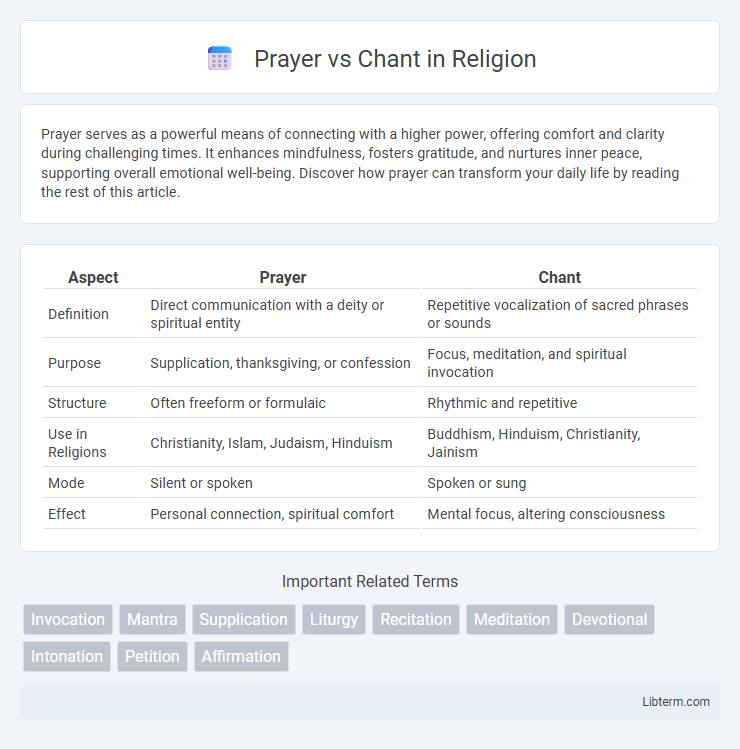Prayer serves as a powerful means of connecting with a higher power, offering comfort and clarity during challenging times. It enhances mindfulness, fosters gratitude, and nurtures inner peace, supporting overall emotional well-being. Discover how prayer can transform your daily life by reading the rest of this article.
Table of Comparison
| Aspect | Prayer | Chant |
|---|---|---|
| Definition | Direct communication with a deity or spiritual entity | Repetitive vocalization of sacred phrases or sounds |
| Purpose | Supplication, thanksgiving, or confession | Focus, meditation, and spiritual invocation |
| Structure | Often freeform or formulaic | Rhythmic and repetitive |
| Use in Religions | Christianity, Islam, Judaism, Hinduism | Buddhism, Hinduism, Christianity, Jainism |
| Mode | Silent or spoken | Spoken or sung |
| Effect | Personal connection, spiritual comfort | Mental focus, altering consciousness |
Understanding the Basics: What is Prayer?
Prayer is a spiritual practice involving direct communication with a deity or higher power, often expressing gratitude, requests, or confession. It typically includes spoken or silent words, thoughts, or intentions aimed at fostering a personal connection with the divine. Unlike chanting, which relies on repetitive vocal sounds or mantras to induce meditation or trance, prayer centers on dialogue and heartfelt expression.
Defining Chant: A Closer Look
Chant involves repetitive vocalization of words or sounds, often rooted in religious or spiritual traditions, designed to induce a meditative or trance-like state. Unlike prayer, which is typically a direct communication or petition to a deity, chant emphasizes rhythm, tone, and communal participation to enhance spiritual focus and group cohesion. Prominent examples include Gregorian chants in Christianity and Vedic chants in Hinduism, both serving ceremonial and devotional purposes.
Historical Origins of Prayer and Chant
Prayer and chant both have ancient origins rooted in religious and spiritual practices across diverse cultures. Prayer historically emerged as direct communication with deities or spiritual forces, evident in early texts such as the Egyptian Pyramid Texts and Mesopotamian hymns dating back over 4,000 years. Chanting developed as rhythmic vocalization in rituals, prominently seen in Vedic traditions of India and Gregorian chants in medieval Christianity, serving to unify communities and enhance spiritual experience.
Key Differences Between Prayer and Chant
Prayer typically involves a direct communication with a deity or spiritual entity, often reflecting personal petitions, gratitude, or confessions. Chanting consists of repetitive vocal expressions or sounds that can be sacred or secular, used primarily to induce a meditative or trance-like state. The key differences lie in intent and structure: prayer is usually a dialogic or introspective act, while chant emphasizes rhythm, repetition, and communal participation.
Spiritual Purpose: Intention and Focus
Prayer centers on personal communication with a divine entity, aiming to express devotion, request guidance, or seek inner peace through focused intention. Chant involves repetitive vocalization of sacred sounds or phrases designed to elevate spiritual awareness and deepen meditative focus. Both practices cultivate mindfulness but differ in their approach: prayer is dialogic and intention-driven, while chant emphasizes rhythmic immersion to transcend ordinary consciousness.
Methods and Practices: How Prayer and Chant Are Performed
Prayer typically involves silent or spoken communication directed toward a deity, often incorporating specific postures such as kneeling or clasped hands, with practices varying from spontaneous requests to structured liturgies. Chanting consists of rhythmic vocalizations or melodic repetitions of sacred texts or mantras, frequently performed in groups to induce meditative or trance-like states, using controlled breathing and precise intonation. Both practices emphasize intentional focus but differ in execution; prayer centers on dialogic connection, while chanting emphasizes sonic harmony and repetitive patterns.
Psychological and Emotional Effects
Prayer often fosters a sense of personal connection, hope, and emotional relief through introspective reflection and expression of faith. Chanting, characterized by rhythmic repetition and vocalization, can induce meditative states, reduce stress, and enhance focus by stimulating the parasympathetic nervous system. Both practices influence brain areas linked to emotion regulation, such as the prefrontal cortex and amygdala, promoting psychological well-being and emotional resilience.
Prayer and Chant Across Different Religions
Prayer serves as a direct communication with a divine entity, found in religions such as Christianity, Islam, and Judaism, often involving personal or communal requests, praise, or confession. Chanting appears prominently in Hinduism, Buddhism, and Sikhism, where rhythmic repetition of mantras or hymns aids meditation, spiritual focus, and connection to sacred sounds. Both practices enhance spiritual experience but vary in structure, intent, and cultural expression across religious traditions.
Modern Adaptations and Trends
Modern adaptations of prayer incorporate digital platforms, apps, and virtual communities to enhance personal and communal spiritual experiences. Chanting has seen a resurgence through mindfulness practices, yoga sessions, and music therapy, often blending traditional mantras with contemporary sounds. Both prayer and chant increasingly emphasize accessibility and personalization to resonate with diverse, global audiences.
Choosing Between Prayer and Chant: Which Suits You?
Choosing between prayer and chant depends on your personal spiritual goals and preferences. Prayer is typically a direct, personal communication with a deity, offering a space for reflection, gratitude, and requests, ideal for those seeking intimacy and emotional expression. Chant, often repetitive and melodic, fosters meditative focus and communal connection, making it suitable for individuals drawn to rhythm, mindfulness, and collective energy in spiritual practice.
Prayer Infographic

 libterm.com
libterm.com